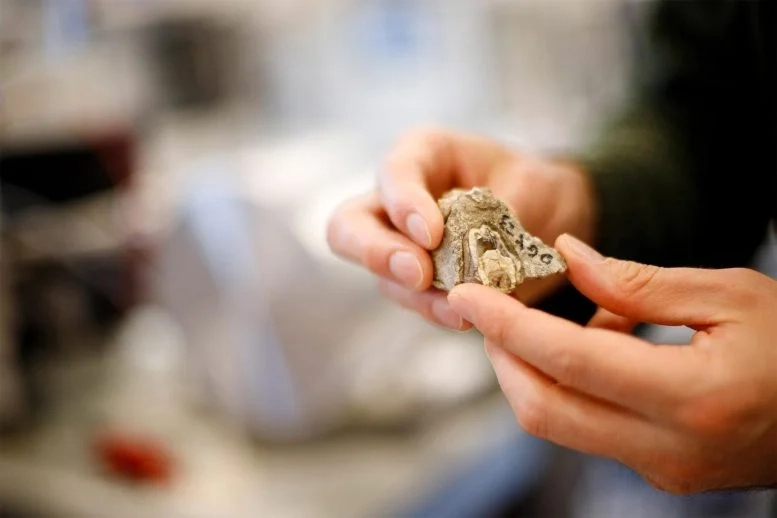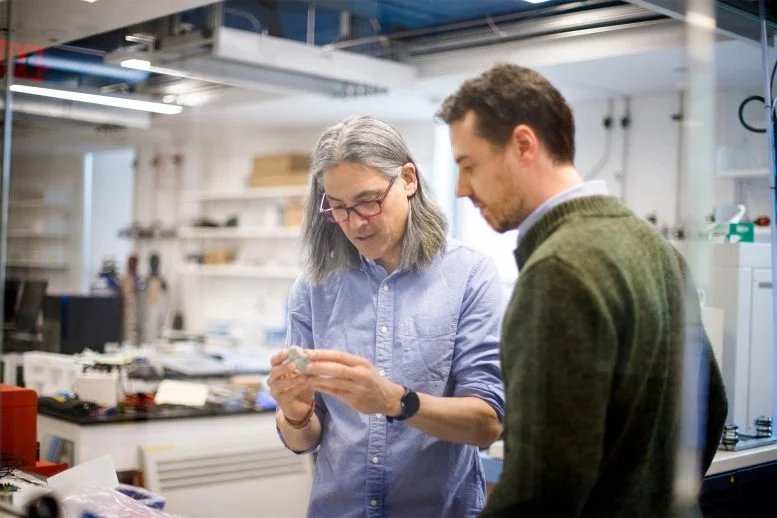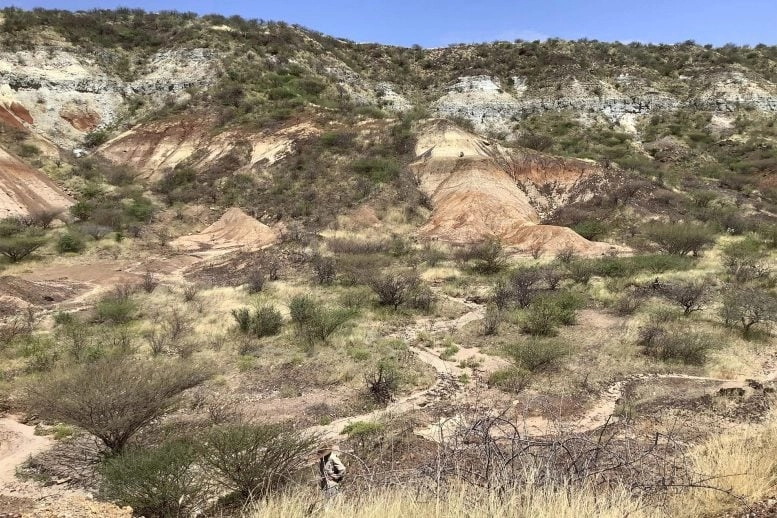 A fossil sample. Credit: Grace DuVal
A fossil sample. Credit: Grace DuVal
Protein remnants in fossil enamel reveal new ways to study evolution. These molecules stretch our view of molecular preservation far into the past.
Proteins naturally break down over time, which makes it difficult to trace their origins and preserve their biological history. However, a recent study has revealed the presence of ancient proteins preserved in the enamel of 18-million-year-old fossilized mammal teeth from Kenyas Rift Valley, offering new insights into how these animals lived and evolved.
In their newly published paper in Nature, researchers from Harvard University and the Smithsonian Museum Conservation Institute detail their discovery. Teeth are rocks in our mouths, said Daniel Green, field program director in the Department of Human Evolutionary Biology and lead author of the study. Theyre the hardest structures that any animals make, so you can find a tooth that is a hundred or a hundred million years old, and it will contain a geochemical record of the life of the animal. This includes information about the animals diet, water sources, and surrounding environment.
 Kevin Uno (left) and Daniel Green look at fossil samples in the lab. Credit: Grace DuVal
Kevin Uno (left) and Daniel Green look at fossil samples in the lab. Credit: Grace DuVal
In the past, we thought that mature enamel, the hardest part of teeth, should really have very few proteins in it at all, said Green. However, utilizing a newer proteomics technique called liquid chromatography tandem mass spectrometry (LC-MS/MS), the team was able to detect a a great diversity of proteins& in different biological tissues.
The technique involves several stages where peptides are separated based on their size or chemistry so that they can be sequentially analyzed at higher resolutions than was possible with previous methods, explained Kevin T. Uno, associate professor in HEB and one of the papers corresponding authors.
We and other scholars recently found that there are dozens if not even hundreds of different kinds of proteins present inside tooth enamel, said Green.
 Night view of field camp at Lothagam, a site in northern Kenya and one of the places where fossil teeth yield ancient proteins. Credit: Daniel Green
Night view of field camp at Lothagam, a site in northern Kenya and one of the places where fossil teeth yield ancient proteins. Credit: Daniel Green
Elephants and rhinos offer thick enamel samples
After confirming that modern teeth contain a wide variety of proteins, the researchers turned their attention to fossils. They partnered with the Smithsonian and the National Museum of Kenya to examine fossilized teeth, focusing on early elephants and rhinoceroses. As plant-eating mammals, these animals had large teeth adapted for grinding vegetation. They can have enamel two to three millimeters thick, said Green. It was a lot of material to work with.
 Green examining fossils from a northern Kenyan site called Napudet. Credit: Fred Horne
Green examining fossils from a northern Kenyan site called Napudet. Credit: Fred Horne
Their analysis revealed peptide fragmentsshort chains of amino acids that form proteinspreserved in these fossils for as long as 18 million years.
Green described the discovery as field-changing. Nobodys ever found peptide fragments that are this old before, he said, adding that the results were kind of shocking. Prior to this study, the oldest known peptide sequences came from materials around three and a half million years old. With the help of our colleague Tim Cleland, a superb paleoproteomicist at the Smithsonian, were pushing back the age of peptide fragments by five or six times what was known before.
 Formed approximately 16 million years ago, the Buluk site in Kenya is found in one of the most remote and inhospitable places in the rift, but has yielded an extraordinary diversity of fossil fauna. Credit: Ellen Miller
Formed approximately 16 million years ago, the Buluk site in Kenya is found in one of the most remote and inhospitable places in the rift, but has yielded an extraordinary diversity of fossil fauna. Credit: Ellen Miller
The peptides identified represent a variety of proteins involved in different biological roles, collectively referred to as the proteome, Green explained.
One of the reasons that were excited about these ancient teeth is that we dont have the full proteome of all proteins that could have been found inside the bodies of these ancient elephants or rhinoceros, but we do have a group of them. He added, there might be more information available from a group of them than just one protein by itself.
New potential in paleobiology and evolution
This research opens new frontiers in paleobiology, allowing scientists to go beyond bones and morphology to reconstruct the molecular and physiological traits of extinct animals and hominins, said Emmanuel K. Ndiema, senior research scientist at the National Museum of Kenya, and paper coauthor. This provides direct evidence of evolutionary relationships. Combined with other characteristics of teeth, we can infer dietary adaptations, disease profiles, and even age at death insights that were previously inaccessible.
 This is a photo of Daniel Green at Lothagam, a site in northern Kenya and one of the places where fossil teeth yield ancient proteins. Credit: Medina Lubisia
This is a photo of Daniel Green at Lothagam, a site in northern Kenya and one of the places where fossil teeth yield ancient proteins. Credit: Medina Lubisia
In addition to shedding light on the lives of these creatures, it helps place them in history. Uno elaborated: We can use these peptide fragments to explore the relationships between ancient animals, similar to how modern DNA in humans is used to identify how people are related to one another.
Even if an animal is completely extinct and we have some animals that we analyze in our study who have no living descendants you can still, in theory, extract proteins from their teeth and try to place them on a phylogenetic tree, said Green. Such information might be able to resolve longstanding debates between paleontologists about what other mammalian lineages these animals are related to using molecular evidence.
 A view of the Turkwel River in Turkana, northern Kenya, where these fossilsfrom which ancient peptides were recoveredare found. Miocene volcanic structures can be seen in the distance: many geological features of this part of the East African Rift System, and the fossils and proteins described in this study, date to the Miocene period (23 to 5 million years old). Credit: Daniel Green
A view of the Turkwel River in Turkana, northern Kenya, where these fossilsfrom which ancient peptides were recoveredare found. Miocene volcanic structures can be seen in the distance: many geological features of this part of the East African Rift System, and the fossils and proteins described in this study, date to the Miocene period (23 to 5 million years old). Credit: Daniel Green
Although this research began as a small side project of a much larger project involving dozens of institutions and researchers from around the world, said Green, we were surprised at just how much we found. There really are a lot of proteins preserved in these teeth.
Reference: Eighteen million years of diverse enamel proteomes from the East African Rift by Daniel R. Green, Kevin T. Uno, Ellen R. Miller, Craig S. Feibel, Eipa Emmanuel Aoron, Catherine C. Beck, Aryeh Grossman, Francis M. Kirera, Martin M. Kirinya, Louise N. Leakey, Cynthia Liutkus-Pierce, Fredrick K. Manthi, Emmanuel K. Ndiema, Isaiah O. Nengo, Cyprian Nyete, John Rowan, Gabrielle A. Russo, William J. Sanders, Tara M. Smiley, Patricia Princehouse, Natasha S. Vitek and Timothy P. Cleland, 9 July 2025, Nature.
DOI: 10.1038/s41586-025-09040-9
This research was partially funded by the National Science Foundation and Smithsonians Museum Conservation Institute.
Never miss a breakthrough: Join the SciTechDaily newsletter.



